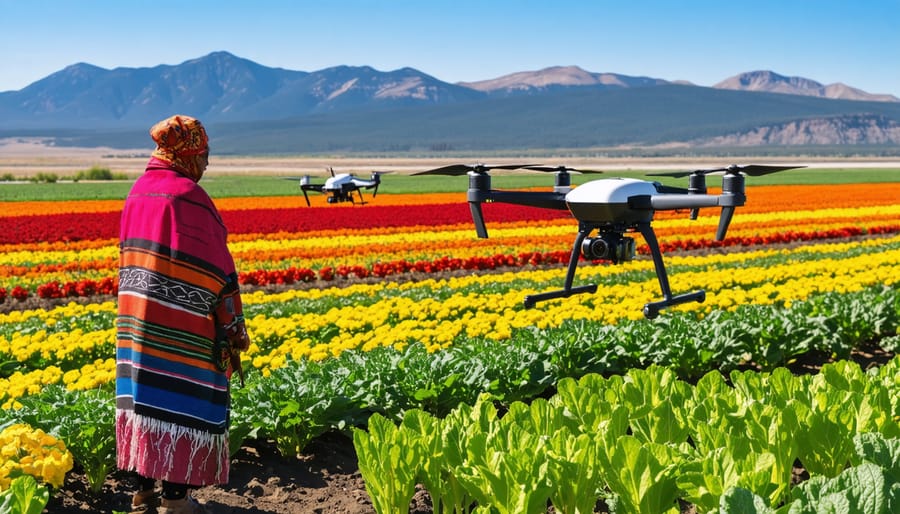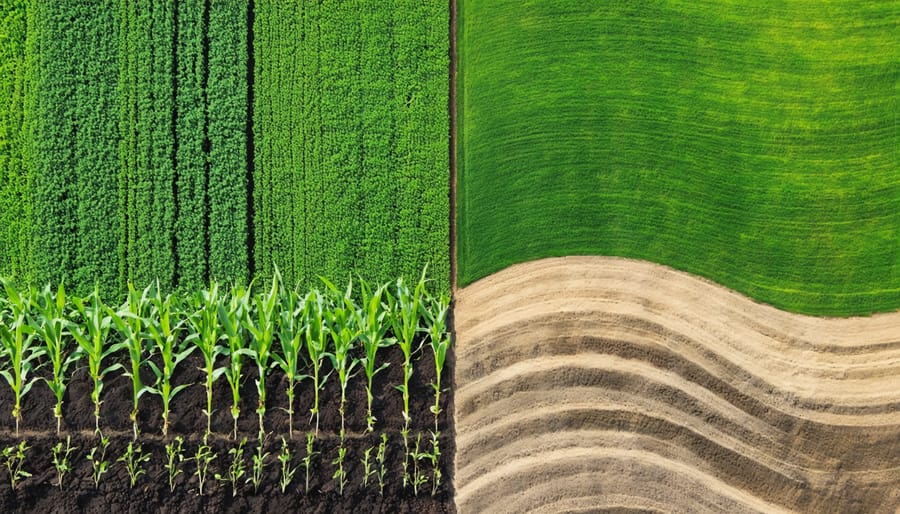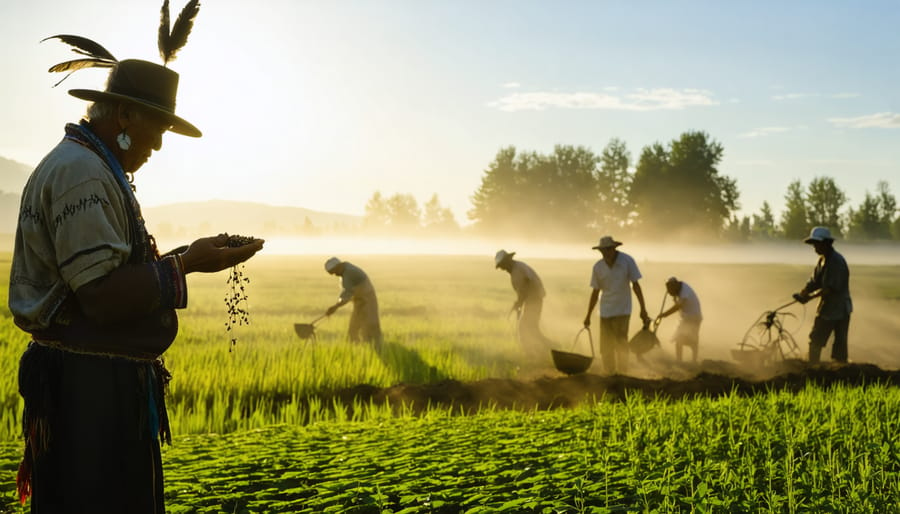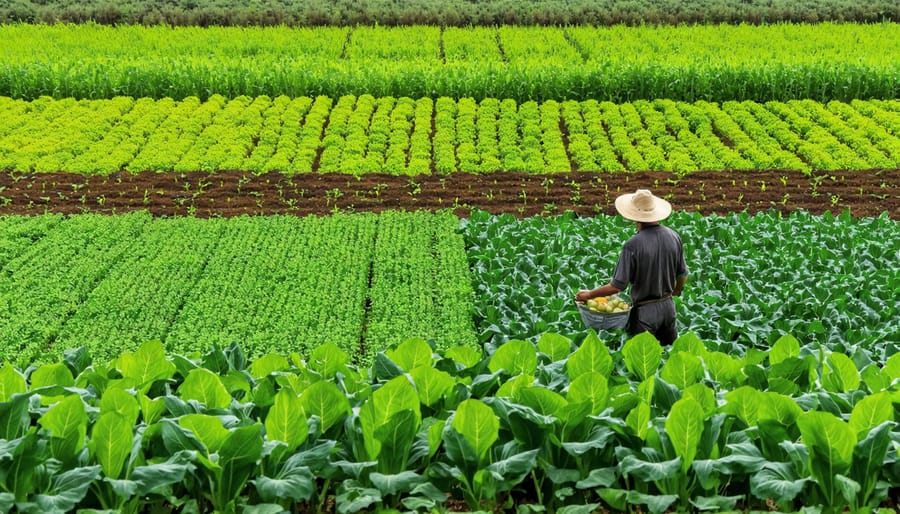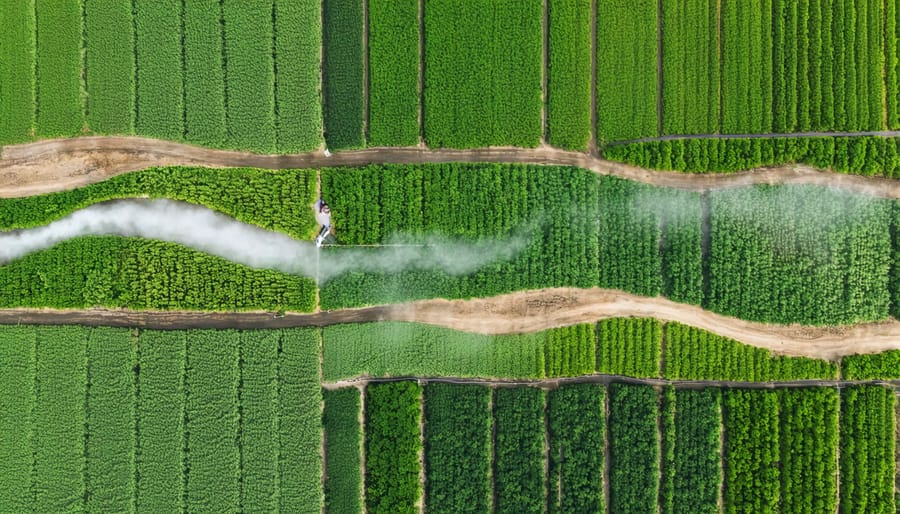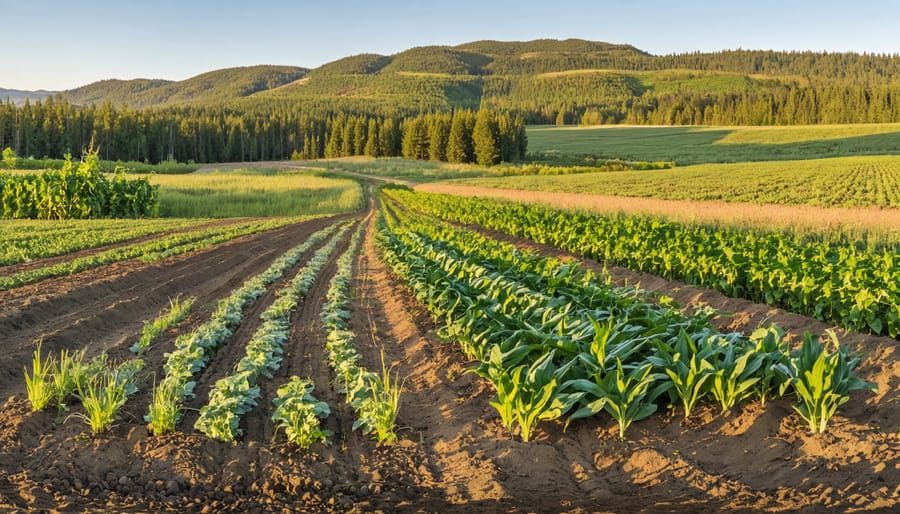Combine Indigenous dryland farming techniques with modern precision agriculture to create resilient, climate-adaptive systems across Alberta’s diverse agricultural zones. Traditional Three Sisters companion planting methods, when integrated with smart irrigation technology and soil moisture sensors, reduce water consumption by 30% while improving crop yields. Building agricultural resilience requires immediate implementation of both time-tested knowledge and emerging technologies – from drought-resistant heritage seed varieties to satellite-guided precision farming.
Prairie farmers already demonstrate this powerful synthesis, with 65% of Alberta producers now utilizing some form of Indigenous-inspired soil conservation alongside advanced weather monitoring systems. These combined approaches have proven particularly effective in managing extreme weather events, reducing crop losses by up to 40% during recent drought cycles.
The urgency of climate adaptation demands we move beyond singular solutions. Strategic integration of traditional ecological knowledge with cutting-edge agricultural innovation offers our best path forward. This practical fusion of old and new wisdom enables farmers to not just survive but thrive amid increasing climate variability while preserving crucial topsoil and water resources for future generations.
Traditional Indigenous Agricultural Wisdom in Alberta
Three Sisters Companion Planting
The Three Sisters planting method, developed by Indigenous peoples across North America, offers modern farmers a resilient approach to climate change adaptation. This traditional technique involves growing corn, climbing beans, and squash together in a mutually beneficial relationship that enhances soil health and crop productivity.
In the corn-beans-squash trio, tall corn stalks provide natural trellises for climbing beans, while the beans fix nitrogen in the soil, benefiting all three crops. The large squash leaves create ground cover that reduces water evaporation and suppresses weed growth, making this system particularly valuable for Alberta’s semi-arid regions.
Recent field trials at the University of Alberta have demonstrated that Three Sisters plantings can reduce irrigation needs by up to 30% compared to conventional monoculture systems. Local farmer Sarah Thompson from Lacombe County reports that implementing this method has improved her soil organic matter by 15% over three growing seasons while reducing fertilizer inputs.
To adapt this ancient technique for modern farms, consider starting with a small test plot of 1-2 hectares. Plant corn in hills spaced 1 metre apart, add pole beans when corn reaches 15 centimetres in height, and introduce squash seedlings two weeks later. This timing allows each crop to establish without competing for resources.
The Three Sisters method exemplifies how traditional agricultural wisdom can help Canadian farmers build resilience against climate variability while maintaining productive and sustainable operations.
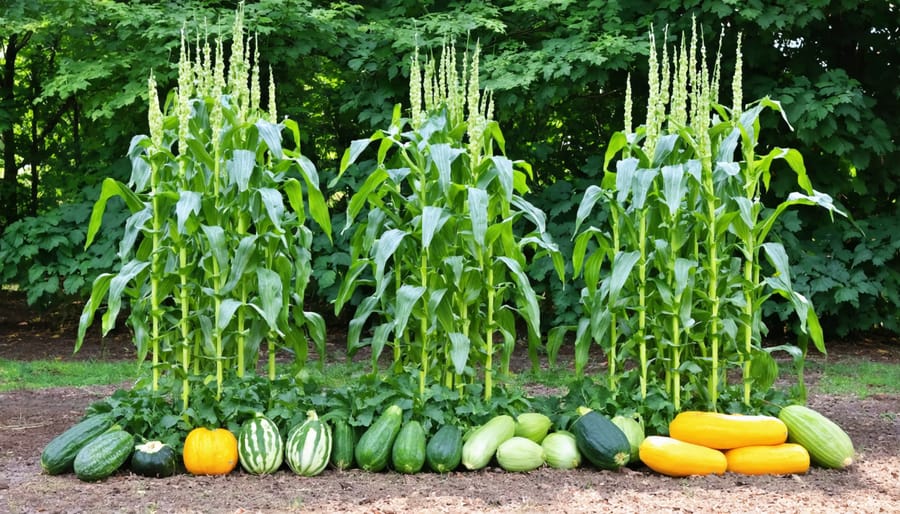
Water Conservation Methods
Indigenous communities across Canada have long practiced traditional water management techniques that are proving invaluable for modern farming challenges. In Alberta, farmers are increasingly adopting these time-tested methods, combining them with contemporary technology to create resilient water conservation systems.
One notable approach is the restoration of natural wetlands and the creation of small retention ponds, inspired by Indigenous practices of working with natural landforms. These features act as natural water storage systems, helping maintain soil moisture during dry periods while supporting local biodiversity.
The integration of keyline design, a technique that follows natural contours of the land to distribute water efficiently, has shown promising results on several Alberta farms. This method, which aligns with Indigenous principles of minimal landscape disruption, has helped reduce irrigation needs by up to 30% in pilot projects.
Modern adaptations of traditional mulching techniques, using locally available materials like straw and wood chips, are being implemented to reduce evaporation and maintain soil moisture. Farmers report significant improvements in water retention, with some noting a 40% reduction in irrigation requirements during summer months.
These water conservation methods not only honor Indigenous agricultural wisdom but also provide practical solutions for modern farming challenges, creating a more sustainable and resilient agricultural system for future generations.
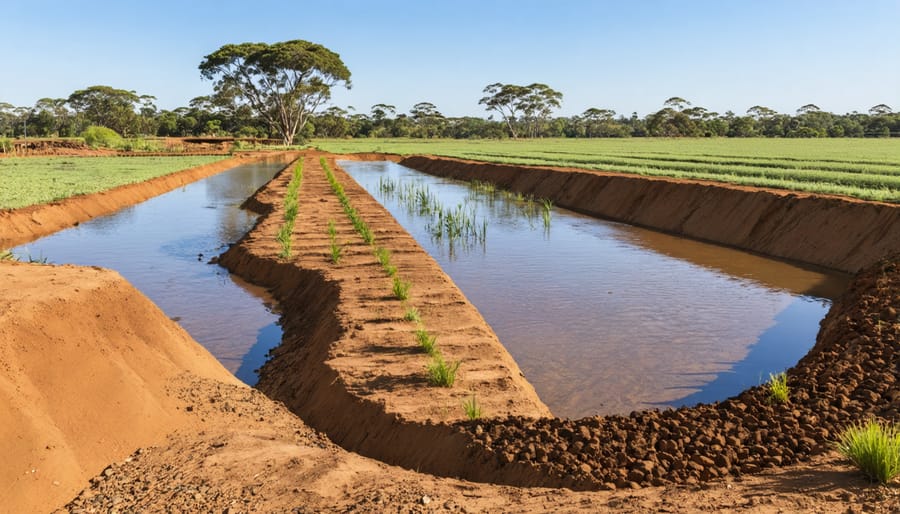
Modern Adaptation Strategies
Drought-Resistant Crop Selection
In Alberta’s changing climate, selecting drought-resistant crops has become increasingly crucial for farm sustainability. Many farmers are turning to heritage crop varieties that have naturally developed resilience over generations of cultivation in our prairie conditions.
Traditional varieties like Red Fife wheat and Purple Prairie barley have demonstrated remarkable adaptability to moisture stress. These crops developed deep root systems and efficient water-use mechanisms long before modern breeding programs began. Today, they’re proving invaluable as we face more frequent dry spells.
Local success stories include the Mackenzie family farm near Lethbridge, where implementing drought-resistant varieties has reduced irrigation needs by 30% while maintaining yields. Their rotation includes drought-tolerant pulse crops like chickpeas and lentils, which also improve soil health through nitrogen fixation.
Modern breeding programs have enhanced these natural adaptations. The University of Alberta’s crop development program has successfully combined traditional variety hardiness with improved yield characteristics. Recent varieties like AAC Brandon wheat and CDC Maverick barley show promise in handling moisture stress while delivering competitive yields.
For smaller-scale operations, ancient grains like Kamut and Spelt offer excellent drought tolerance and premium market opportunities. These crops typically command higher prices and align well with the growing consumer demand for heritage grains.
When selecting drought-resistant crops, consider your specific soil conditions and typical rainfall patterns. Start small with test plots to evaluate performance in your microclimate. Remember that successful drought resistance often comes from a combination of appropriate variety selection and good soil management practices, including maintaining organic matter and implementing moisture-conservation techniques.
Connect with local agricultural extension offices and experienced farmers in your area who have successfully implemented drought-resistant varieties. Their practical experience can provide valuable insights into which varieties perform best under local conditions.
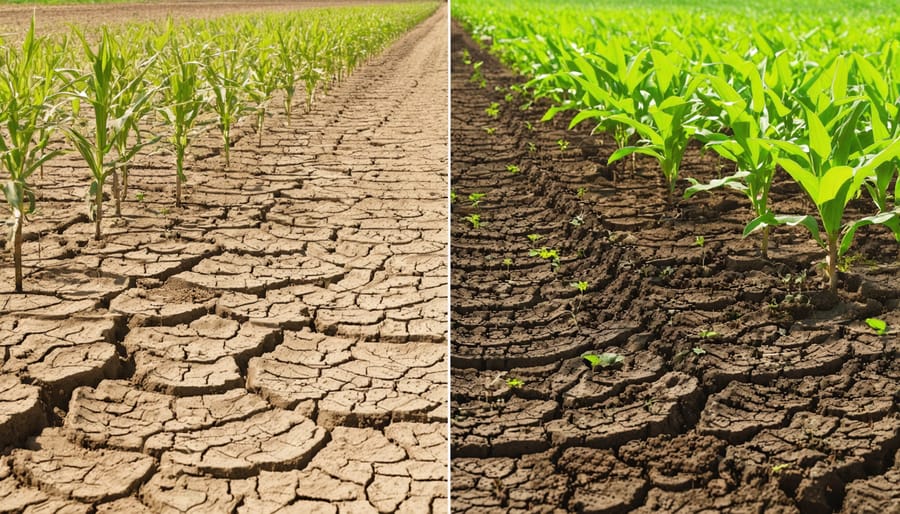
Soil Health Management
In Alberta’s ever-changing agricultural landscape, farmers are increasingly turning to ancient soil practices that have sustained Indigenous communities for generations. These time-tested methods are proving invaluable in building resilient farming systems capable of withstanding climate pressures.
Traditional Indigenous approaches to soil management emphasize the interconnectedness of all living systems. For instance, the Three Sisters planting method – combining corn, beans, and squash – naturally enhances soil fertility while maximizing land use. Modern farmers in Southern Alberta have adapted this technique, reporting improved soil structure and reduced erosion on their fields.
Key Indigenous soil management practices being successfully integrated include:
– Minimal soil disturbance techniques that preserve soil structure
– Strategic crop rotation patterns that mirror natural ecological succession
– Integration of native plant species as cover crops
– Use of natural mulching materials to retain moisture and protect soil
Local farmer Dave Thompson from Lethbridge County shares his success: “By incorporating Indigenous knowledge about working with the land rather than against it, we’ve seen our soil organic matter increase by 2% over five years, while reducing our fertilizer needs by nearly 30%.”
These practices are particularly relevant as Alberta faces increasing climate variability. The traditional Indigenous approach of viewing soil as a living ecosystem aligns perfectly with modern regenerative agriculture principles. Many farmers are now combining these ancestral methods with current technology, using soil moisture sensors and weather monitoring systems to optimize traditional practices.
Community-led initiatives across the province are facilitating knowledge sharing between Indigenous elders and farmers, creating a bridge between traditional wisdom and contemporary farming needs. These collaborations are proving that sustainable soil management isn’t just about preserving the land – it’s about preserving knowledge that has sustained communities for centuries.
Case Study: Success Stories from Alberta’s First Nations Farms
The Siksika Nation, located 100 kilometers east of Calgary, has emerged as a leading example of successful climate adaptation in agriculture. Through their innovative Blackfoot Agricultural Project, they’ve combined traditional knowledge with modern farming techniques to create resilient farming systems that thrive despite increasingly unpredictable weather patterns.
Elder John Yellow Old Woman, who leads the project, explains how traditional Three Sisters planting methods have been adapted for larger-scale farming. “Our ancestors knew that corn, beans, and squash work together to strengthen the soil and conserve water. We’ve scaled this principle to protect our 20,000 hectares of farmland from drought and erosion.”
The Blood Tribe Agricultural Project (BTAP) in southern Alberta presents another success story. Their implementation of drought-resistant crop varieties and water-smart irrigation systems has increased crop yields by 30% over the past five years, even during periods of reduced rainfall. The project manager, Sarah Running Horse, attributes their success to combining Indigenous water management practices with modern precision agriculture technology.
In the Lesser Slave Lake region, the Sawridge First Nation has pioneered an innovative approach to soil conservation. Their regenerative agriculture program incorporates traditional burning practices with modern cover cropping techniques. This combination has improved soil organic matter by 25% and reduced the need for chemical fertilizers by nearly half.
The Alexander First Nation, just northwest of Edmonton, has developed a remarkable greenhouse operation that extends the growing season by up to three months. Their system integrates traditional knowledge about cold-hardy plants with passive solar design, allowing year-round production of various vegetables while reducing energy costs by 40%.
These success stories share common elements: respect for traditional knowledge, openness to innovation, and strong community involvement. The projects have created employment opportunities, improved food security, and demonstrated climate resilience strategies that other farms across Alberta can adopt.
Importantly, these initiatives have fostered knowledge-sharing networks between Indigenous and non-Indigenous farmers. Annual gatherings hosted by these First Nations communities have attracted over 500 farmers from across the province, creating valuable opportunities for cross-cultural learning and collaboration in sustainable agriculture practices.
Implementation Guide for Alberta Farmers
Getting Started
Beginning your journey toward implementing mitigation and adaptation strategies doesn’t have to be overwhelming. Start by conducting a thorough assessment of your farm’s current practices and vulnerabilities. Consider partnering with local agricultural extension services or joining farmer-led discussion groups in your area to share experiences and learn from others.
A crucial first step is understanding how Indigenous permaculture principles can be integrated with modern farming techniques. Many Alberta farmers have found success by starting small, perhaps by implementing cover crops on a portion of their land or introducing windbreaks to protect sensitive areas.
Connect with your local Agricultural Service Board for soil testing services and customized recommendations for your specific region. The Alberta Climate Information Service (ACIS) provides valuable weather and climate data to help inform your planning decisions. Consider joining sustainable agriculture networks or attending workshops offered through organizations like the Organic Alberta or Young Agrarians.
Start building a resource library that includes local climate projections, soil health guides, and water management strategies. Many experienced farmers recommend beginning with low-cost, high-impact practices like crop rotation and reduced tillage before moving on to more significant investments in infrastructure or equipment.
Remember, successful adaptation is a journey, not a race. Focus on making gradual, sustainable changes that work for your specific operation and local conditions.
Community Collaboration
Building strong partnerships with Indigenous communities has emerged as a crucial component of successful climate change mitigation in Alberta’s agricultural sector. Many First Nations communities have maintained traditional ecological knowledge passed down through generations, offering valuable insights into sustainable land management and resilient farming practices.
The Blackfoot, Stoney Nakoda, and Cree peoples have long practiced methods of crop rotation, water conservation, and soil preservation that align remarkably well with modern sustainable agriculture principles. Several successful collaborations between Alberta farmers and Indigenous communities have demonstrated the power of combining traditional wisdom with contemporary farming techniques.
For example, the Standing Grass Project in southern Alberta brings together local farmers and Blackfoot elders to share knowledge about drought-resistant native grasses and traditional water management systems. This partnership has helped farmers develop more resilient cropping systems while preserving Indigenous agricultural heritage.
The Treaty 7 Agricultural Initiative has created mentorship programs where Indigenous knowledge keepers work alongside farmers to implement sustainable practices that respect the land while maintaining productive yields. These collaborations have led to the adoption of companion planting techniques, natural pest management strategies, and more efficient water use methods.
To build meaningful partnerships, farmers are encouraged to approach Indigenous communities with respect, openness to learning, and a commitment to long-term relationship building. Local agricultural extension offices can help facilitate these connections and provide resources for collaborative projects.
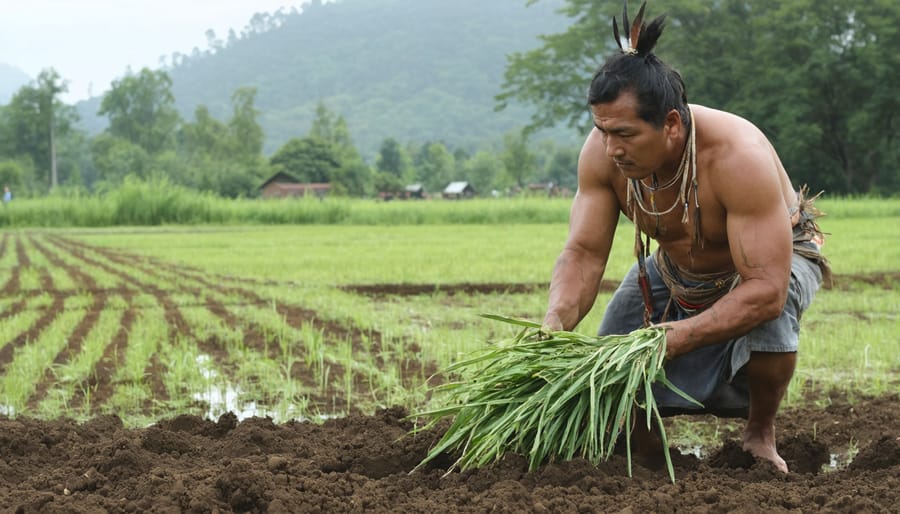
As we look to the future of farming in Alberta, the integration of traditional Indigenous agricultural knowledge with modern farming practices presents a powerful pathway forward. Our local farming communities have long recognized that the most resilient solutions often emerge when we bridge generational wisdom with contemporary innovation.
The success stories from farms across the province demonstrate how this combined approach yields remarkable results. For instance, the adoption of traditional Three Sisters companion planting methods alongside precision agriculture technology has helped numerous Alberta farmers improve soil health while maximizing yield efficiency. These farmers report stronger crop resilience and reduced input costs while maintaining productive harvests.
Elder Joseph Standing Bear of the Siksika Nation reminds us that “the land speaks to those who listen.” This philosophy, when paired with modern soil monitoring systems and weather forecasting technology, creates a more comprehensive understanding of our agricultural ecosystems. Many Alberta farmers now incorporate Indigenous principles of land stewardship while utilizing advanced irrigation systems and crop rotation strategies.
Moving forward, we must continue to foster knowledge-sharing between Indigenous elders and agricultural scientists. The Alberta Agricultural Research Institute’s recent initiatives to document and implement traditional farming practices alongside modern methods serve as an excellent model for other regions.
Remember, successful adaptation to global change doesn’t require choosing between old and new – it’s about finding the sweet spot where both approaches complement each other. By embracing this balanced perspective, our farming community can build more resilient and sustainable agricultural systems that will serve future generations well.
The path ahead requires openness to learning from all sources of wisdom, whether they come from centuries of traditional knowledge or the latest agricultural innovations. Together, we can create farming practices that are both deeply rooted in proven methods and ready to face tomorrow’s challenges.

